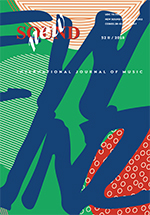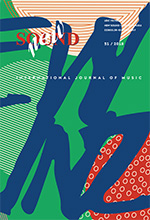Issue No. 42
Composer Speaks
Milena Medić – MUSIC IS NOT A LANGUAGE – INTERVIEW WITH MILOŠ ZATKALIK
Download: ser / eng
Music – Politics – Language
Miško Šuvaković – AESTHETICS, POLITICS AND MUSIC IN THE CONTEXT OF CONTEMPORARY CRITICAL THEORY
Download: ser / eng
François Nicolas – ETRELACER MUSIQUE ET POLITIQUE?
Download: ser / eng
Dario Martinelli – POPULAR MUSIC, SOCIAL PROTEST AND THEIR SEMIOTIC IMPLICATIONS
Abstract: The goal of this article is to discuss the relationship between popular music (song writing, in particular) and issues of social protest, as portrayed in the various reper- toires. The interface of the analysis is of a semiotic type, and the steps will follow a path that goes from problematizing the issue as such (with an emphasis on the current difficulties of identifying protest songs in terms of “genre”), to the definition of those stylistic elements pertaining to the context (in/for which these songs are written and/or played), the themes (as appearing from the lyrics) and the music itself (with the implication that the latter aspect is normally underrated in its significance, within such a process).
Download: ser / eng
Tyrus Miller – ON ALBRECHT WELLMER: MUSIC AND MODERNISM AFTER HABERMAS
Download: ser / eng
Erik Vogt – MUSIC DRAMA AND POLITICS: PHILLIPE LACOUE-LABARTHE AND ALAN BADIOU ON RICHARD WAGNER'S IDEA OF THE GESAMKUNSTWERK
Abstract: This paper sketches the debate between Philippe Lacoue-Labarthe and Alain Badiou concerning Richard Wagner’s idea of the Gesamtkunstwerk. Following in part the account of the Gesamtkunstwerk that was developed in Theodor W. Adorno’s pivotal text In Search of Wagner, Lacoue-Labarthe regards the notion of Gesamtkunstwerk as the central key for unlocking the implications of Wagner’s theory and practice of music drama. That is to say, Lacoue-Labarthe claims that the fusion of art and politics characterizing the Gesamtkunstwerk can only be grasped by unearthing the conception of (romantic) aesthetics that underlies Wagner’s staging of the relationship between art and politics. Lacoue-Labarthe identifies Wagnerian aesthetics as the anticipation of national-aestheticism (a term that Lacoue-Labarthe elaborates in the context of his reading of Heidegger’s deconstruction of aesthetics) that finds its completion in National Socialism. Consequently, Wagner’s art taking figure in the Gesamtkunstwerk engenders totalitarian politics. In critical opposition to Lacoue-Labarthe, Alain Badiou both relegates the idea of the Gesamtkunstwerk to the realm of mere ideology and demonstrates that the former obscures the complex relationship between art and politics that is actually engendered in Wagner’s music dramas. Once the idea of the Gesamtkunstwerk is dismissed as the central category of Wagnerian artistic production, one can return to Wagner’s music dramas as sites both for a “music of the future” and a different conception of politics.
Keywords: Richard Wagner; Philippe Lacoue-Labarthe; Alain Badiou; Music drama; Gesamkunstwek.
Download: ser / eng
Dragana Jeremić Molnar – INCEPTION OF WAGNER'S DOCTRINE OF REGENERATION PRIOR TO THE REVOLUTION 1848–1849
Abstract: The predominant opinion in contemporary science is that Richard Wagner began formulating his doctrine of regeneration in the 1860s, with a subsequent elaboration in the so-called regeneration writings, creating a sort of theoretical platform for working on Parsifal, a festival play for the consecration of the stage. Wagner’s written legacy, however, shows that he had been thinking about regeneration ever since the 1840s, as well as that he used the term in a broad range of meanings – especially considering that he used that word of the French origin as the synonym for the German word Wiedergeburt. This paper focuses on three instances where he referred to regeneration in the fifth decade of the 19th century: a letter from 1843, a text “How do republican aspirations stand in relation to the monarchy?”, and a paper Art and Revolution. In 1843, Wagner had only vague ideas about regeneration in art; five years later, while the city of Dresden was eagerly awaiting the revolutionary wave from France, it was the rebirth of human society that he had in mind; after the collapse of the revolution, realizing his limitations and dispelling illusions about its success, he established a correlation – never to be dismissed – between regeneration and art; i.e. he fancied that the regeneration of the being of a nation’s members could be achieved by exposing them to the effects of a special, true art.
Keywords: Wagner, regeneration, rebirth, revolution, France, Germany.
Download: ser / eng
Andrija Filipović – MUSICA INHUMANA: TOWARDS THE POSTHUMANISTIC ETHICAL AND AESTHETICAL PARADIGM IN MUSIC
Abstract: This paper deals with the analysis of noise music by the Japanese artist Merzbow, especially emphasizing the posthumanistic ethical and aesthetical paradigm as his artistic and political project. This project, or assemblage, has several aspects, three being particularly important: ‘musical’ system (acoustic material, creator, listener), visual and textual material (album covers, articles and interviews), and the attitude towards the nonhuman (machines, animals, nature in general). These three aspects are a particular assem- blage that enables the critique of the “everyday body” and the contemporary society, by creating special aesthetics of existence and lines of flight, an aesthetics which, ultimately, removes the human subject and replaces it with an (in)organic multiplicity.
Keywords: noise, Merzbow, masochism, posthumanism, aesthetics of organisation.
Download: ser / eng
New Works
Vesna Mikić – WHO AM I – I AM?: REFLECTIONS OF/ON SELF IN SRĐAN HOFMAN'S OGLEDALO [MIRROR] FOR TRIO (MEZZO-SOPRANO, VIOLONCELLO, PIANO) AND CHAMBER ENSEMBLE (2012)
Abstract: The article deals with Srđan Hofman’s recent piece – Ogledalo for trio and chamber ensemble. The interpretation aims at discovering the vehicles for Hofman’s pro- cedures, as well as defining the results he achieved in the piece. Starting from the assump- tion that the piece, in a way, sublimates all of his previous achievements, the article follows the lines of Hofman’s mature poetics in the form of a ‘story’ of composers search- ing and finding the answers to ontological, phenomenological and existential questions.
Keywords: Serbian music, Srđan Hofman, chamber music, sound objects, becoming.
Download: ser / eng
Radoš Mitrović – SUITE JURIJEV KRUG FOR THE OPERA ZVEZDANI GRAD BY DRAGANA JOVANOVIĆ; CHAMBER OPERA KO JE UBIO PRINCEZU MOND? BY TATJANA MILOŠEVIĆ; CHAMBER OPERA PETERSBURG BY BRANKA POPOVIĆ
Abstract: Three works by contemporary Serbian female composers, although disparate as to the manner of their realization, do have some similarities. An affinity can be perceived by analysing the poetical planes supporting the textual bases of these compositions, as well as their relationships with the musical component. The intersections can be found in the specific attitude towards the subject and the subject’s identity, problematized in the librettos, as well as in the issue of the time/space dichotomy within the narrative.
Keywords: Dragana Jovanović, Tatjana Milošević, Branka Popović, chamber opera, Dragan Živadinov, postgravity art, Morian Lagartia, Andrei Bely.
Download: ser / eng
Branka Radović – NEW WORKS INSPIRED BY NJEGOŠ (MARKING THE BICENTENARY OF THE BIRTH OF P. P. NJEGOŠ)
Abstract: Celebrations of Njegoš’s anniversaries have always been an opportunity for the artist to approach – Njegoš. This also happened on the latest, 200th anniversary of Njegoš’s birth. Compositions commissioned from Montenegrin authors Žarko Mirković, Aleksandar Perunović and Nina Perović were premiered in Podgorica on 20th April 2013, and later performed in Negotin, at the Mokranjčevi dani [Days of Mokranjac] festival, on 19th September 2013.
Keywords: celebration, lament, Gorski vijenac / The Mountain Wreath, vocal language, choral texture, harmonic language.
Download: ser / eng
Analyses
Paolo Susanni – TONAL PROGRESSION IN BARTÓK’S ETUDES, OP. 18
Abstract: Bartók’s mature musical language was born of both folk and art-music sources which influenced the composer in equal measure. The Three Studies for piano, Op. 18, represent a significant step in the evolution of the composer’s synthesis of the art-music source. All three etudes are based on equal-interval chains called interval cycles. Each of the three etudes represents a stage in the process of intervallic augmentation the composer named diatonic expansion. This concept, together with that of chromatic compression, is fundamental to all his mature works. The first etude expands the chromatic scale to two whole-tone scales. In the second etude the intervals are expanded to include the minor and major thirds as well as the perfect fourth, while in the third etude the tritone becomes the final step in the expansion process. The interactions of the ever-expanding interval cycles generate an array of diatonic, non-diatonic and abstract pitch collections. Parts of the opus rely on the concept of tonal progression based on axes of symmetry, which reached its perfection in later works such as the Out of Doors Suite and Music for Strings, Percussion and Celesta.
Download: ser / eng
Research and Tradition
Milica Gajić – 'SHORT LEXICON' OF DEDICATIONS IN THE HANDWRITTEN LEGACY OF JOSIP SLAVENSKI (1896–1955) IN THE LIBRARY OF THE FACULTY OF MUSIC IN BELGRADE
Abstract: The paper presents some aspects of the handwritten legacy of Josip Slavenski, stored in the Library of the Faculty of Music in Belgrade – dedications that the composer wrote by his own hand are collected in one place. These are mainly dedications to musicalperformers – soloists and ensembles. They reveal many biographical details from the author’s life – from performances of his works to friendly and professional contacts. Perceiving Josip Slavenski’s oeuvre from this aspect calls to mind many associations with the general artistic climate of the age he was living and working in.
Keywords: Josip Slavenski, dedications, handwritten legacy, Library of the Faculty of Music in Belgrade.
Download: ser / eng
Students' papers
Bojan Miljević – MUSICAL WORLD OF HILDEGARD OF BINGEN
Download: ser / eng
Interpretations
Ivana Petković – UN ART AUTRE: MIKEL DUFRENNE ON POLITICS AND ART. BOOK REVIEW: MIKEL DIFREN, UMJETNOST I POLITIKA [MIKEL DUFRENNE, ART ET POLITIQUE], TRANS. JUGANA STOJANOVIĆ , SVJETLOST, SARAJEVO, 1982
Download: ser / eng
Reviews
Ivana Miladinović Prica – Identities: The World of Music in Relation to Itself. Tilman Seebass, Mirjana Veselinović-Hofman and Tijana Popović Mladenović (eds.) Belgrade, Faculty of Music in Belgrade, 2012, 163 ISBN 978-86-88619-21-9
Download: ser / eng
Selena Rakočević – Andriy Nahachewsky, Ukrainian Dance: A Cross-Cultural Approach. McFarland & Company, Jefferson, North Carolina, and London, 2012, pp. 268
Download: ser / eng
Marija Dumnić – Julie C. Dunbar, Women, Music, Culture: An Introduction. Routlege, New York – London, 2011, pp. XIX+379
Download: ser / eng


